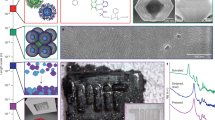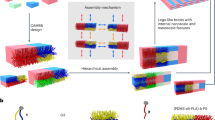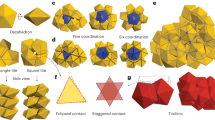Abstract
Spontaneous hierarchical self-organization of nanometre-scale subunits into higher-level complex structures is ubiquitous in nature. The creation of synthetic nanomaterials that mimic the self-organization of complex superstructures commonly seen in biomolecules has proved challenging due to the lack of biomolecule-like building blocks that feature versatile, programmable interactions to render structural complexity. In this study, highly aligned structures are obtained from an organic–inorganic mesophase composed of monodisperse Cd37S18 magic-size cluster building blocks. Impressively, structural alignment spans over six orders of magnitude in length scale: nanoscale magic-size clusters arrange into a hexagonal geometry organized inside micrometre-sized filaments; self-assembly of these filaments leads to fibres that then organize into uniform arrays of centimetre-scale bands with well-defined surface periodicity. Enhanced patterning can be achieved by controlling processing conditions, resulting in bullseye and ‘zigzag’ stacking patterns with periodicity in two directions. Overall, we demonstrate that colloidal nanomaterials can exhibit a high level of self-organization behaviour at macroscopic-length scales.
This is a preview of subscription content, access via your institution
Access options
Access Nature and 54 other Nature Portfolio journals
Get Nature+, our best-value online-access subscription
$29.99 / 30 days
cancel any time
Subscribe to this journal
Receive 12 print issues and online access
$259.00 per year
only $21.58 per issue
Buy this article
- Purchase on Springer Link
- Instant access to full article PDF
Prices may be subject to local taxes which are calculated during checkout





Similar content being viewed by others
Data availability
The data supporting the findings of this study are available within the paper, and other findings of this study are available from the corresponding authors upon reasonable request.
References
Begley, M. R., Gianola, D. S. & Ray, T. R. Bridging functional nanocomposites to robust macroscale devices. Science 364, eaav4299 (2019).
Boles, M. A., Engel, M. & Talapin, D. V. Self-assembly of colloidal nanocrystals: from intricate structures to functional materials. Chem. Rev. 116, 11220–11289 (2016).
Liu, Y.-H., Wang, F., Wang, Y., Gibbons, P. C. & Buhro, W. E. Lamellar assembly of cadmium selenide nanoclusters into quantum belts. J. Am. Chem. Soc. 133, 17005–17013 (2011).
Williamson, C. B. et al. Chemically reversible isomerization of inorganic clusters. Science 363, 731–735 (2019).
Grzelczak, M., Vermant, J., Furst, E. M. & Liz-Marzán, L. M. Directed self-assembly of nanoparticles. ACS Nano 4, 3591–3605 (2010).
Fan, J. A. et al. Self-assembled plasmonic nanoparticle clusters. Science 328, 1135–1138 (2010).
Vukusic, P. & Sambles, J. R. Photonic structures in biology. Nature 424, 852–855 (2003).
Denton, E. Reflectors in fishes. Sci. Am. 224, 64–75. (1971).
Winfree, E., Liu, F., Wenzler, L. A. & Seeman, N. C. Design and self-assembly of two-dimensional DNA crystals. Nature 394, 539–544 (1998).
Ball, P. The Self-Made Tapestry: Pattern Formation in Nature (Oxford Univ. Press, 2001).
Szustakiewicz, P. et al. Supramolecular chirality synchronization in thin films of plasmonic nanocomposites. ACS Nano 14, 12918–12928 (2020).
Jones, A. C. Molecular design of improved precursors for the MOCVD of electroceramic oxides. J. Mater. Chem. 12, 2576–2590 (2002).
Lagerwall, J. P. F. et al. Cellulose nanocrystal-based materials: from liquid crystal self-assembly and glass formation to multifunctional thin films. NPG Asia Mater. 6, e80 (2014).
Mohammadi, E. et al. Dynamic-template-directed multiscale assembly for large-area coating of highly-aligned conjugated polymer thin films. Nat. Commun. 8, 16070 (2017).
Bangsund, J. S. et al. Formation of aligned periodic patterns during the crystallization of organic semiconductor thin films. Nat. Mater. 18, 725–731 (2019).
Alivisatos, A. P. Perspectives on the physical chemistry of semiconductor nanocrystals. J. Phys. Chem. 100, 13226–13239 (1996).
Yin, Y. & Alivisatos, A. P. Colloidal nanocrystal synthesis and the organic–inorganic interface. Nature 437, 664–670 (2005).
Boneschanscher, M. P. et al. Long-range orientation and atomic attachment of nanocrystals in 2D honeycomb superlattices. Science 344, 1377–1380 (2014).
Geuchies, J. J. et al. In situ study of the formation mechanism of two-dimensional superlattices from PbSe nanocrystals. Nat. Mater. 15, 1248–1254 (2016).
Alivisatos, A. P. et al. Organization of ‘nanocrystal molecules’ using DNA. Nature 382, 609–611 (1996).
Mirkin, C. A., Letsinger, R. L., Mucic, R. C., Storhoff, J. J. & DNA-Based, A. Method for rationally assembling nanoparticles into macroscopic materials. Nature 382, 607–609 (1996).
Wang, S. et al. Colloidal crystal engineering with metal–organic framework nanoparticles and DNA. Nat. Commun. 11, 2495 (2020).
Heuer-Jungemann, A. et al. The role of ligands in the chemical synthesis and applications of inorganic nanoparticles. Chem. Rev. 119, 4819–4880 (2019).
Nevers, D. R. et al. Mesophase formation stabilizes high-purity magic-sized clusters. J. Am. Chem. Soc. 140, 3652–3662 (2018).
Baek, W. et al. Highly luminescent and catalytically active suprastructures of magic-sized semiconductor nanoclusters. Nat. Mater. 20, 650–657 (2021).
Nevers, D. R., Williamson, C. B., Hanrath, T. & Robinson, R. D. Surface chemistry of cadmium sulfide magic-sized clusters: a window into ligand–nanoparticle interactions. Chem. Commun. 53, 2866–2869 (2017).
Zhu, C., Lu, Y., Jiang, L. & Yu, Y. Liquid crystal soft actuators and robots toward mixed reality. Adv. Funct. Mater. 31, 2009835 (2021).
Bishop, K. J. M., Wilmer, C. E., Soh, S. & Grzybowski, B. A. Nanoscale forces and their uses in self-assembly. Small 5, 1600–1630 (2009).
Schapotschnikow, P. & Vlugt, T. J. H. Understanding interactions between capped nanocrystals: three-body and chain packing effects. J. Chem. Phys. 131, 124705 (2009).
Tan, S. F., Chee, S. W., Lin, G. & Mirsaidov, U. Direct observation of interactions between nanoparticles and nanoparticle self-assembly in solution. Acc. Chem. Res. 50, 1303–1312 (2017).
Blyholder, G., Adhikar, C. & Proctor, A. Structure and orientation of oleic acid adsorbed onto silica gel. Colloids Surf. A 105, 151–158 (1995).
Kumar, A. & Molinero, V. Self-assembly of mesophases from nanoparticles. J. Phys. Chem. Lett. 8, 5053–5058 (2017).
Viney, C. & Putnam, W. S. The banded microstructure of sheared liquid-crystalline polymers. Polymer 36, 1731–1741 (1995).
Hamdi, R., Petriashvili, G., De Santo, M. P., Lombardo, G. & Barberi, R. Electrically controlled 1D and 2D cholesteric liquid crystal gratings. Mol. Cryst. Liq. Cryst. 553, 97–102 (2012).
Godinho, M. H., Fonseca, J. G., Ribeiro, A. C., Melo, L. V. & Brogueira, P. Atomic force microscopy study of hydroxypropylcellulose films prepared from liquid crystalline aqueous solutions. Macromolecules 35, 5932–5936 (2002).
Chung, W.-J. et al. Biomimetic self-templating supramolecular structures. Nature 478, 364–368 (2011).
Kim, S. H., Misner, M. J., Xu, T., Kimura, M. & Russell, T. P. Highly oriented and ordered arrays from block copolymers via solvent evaporation. Adv. Mater. 16, 226–231 (2004).
Grason, G. M. & Bruinsma, R. F. Chirality and equilibrium biopolymer bundles. Phys. Rev. Lett. 99, 098101 (2007).
Grason, G. M. Braided bundles and compact coils: the structure and thermodynamics of hexagonally packed chiral filament assemblies. Phys. Rev. E 79, 041919 (2009).
Yu, W. W. & Peng, X. Formation of high-quality CdS and other II–VI semiconductor nanocrystals in noncoordinating solvents: tunable reactivity of monomers. Angew. Chem. Int. Ed. Engl. 41, 2368–2371 (2002).
Acknowledgements
This work was supported in part by the National Science Foundation (NSF) under award numbers CHE-1507753, CHE-2003586, CMMI-1941135, CHE-1665305 and DMR-1809429. Electron microscopy was supported by the NSF under award number DMR-1654596. This work was partially supported by the Cornell Center for Materials Research and made use of the Cornell Center for Materials Research shared facilities, with funding from the the NSF MRSEC programme (number DMR-1719875). R.S.S. acknowledges financial support from the NSF Graduate Research Fellowship Programme under grant no. DGE-1650441. From the Department of Chemical and Biomolecular Engineering at Cornell University, we thank Y. Cheng for AFM analysis and K. Niccum and M. Johnson for their pioneering work.
Author information
Authors and Affiliations
Contributions
H.H. and S.K. synthesized high-quality MSCs and thin films used in the main studies. H.H., S.K., C.B.W. and D.R.N. performed OM and POM. H.H. performed atomic force microscopy, scanning electron microscopy and UV-vis absorption spectroscopy. S.K. conducted laser diffraction experiments, simulations, and optical analysis. H.H. and Y.Y. measured circular and LD spectroscopy and carried out TEM imaging. B.H.S. and L.F.K. carried out high-resolution STEM. R.S.S. and J.D. contributed to the modelling and understanding of how the strain energy of twisting leads to monodisperse cable thickness. M.X. synthesized and prepared thin films from CdOl nanoclusters and CdS nanoparticles. O.V. calculated dipoles and dipole–dipole interactions between MSCs. S.J.W. contributed the theoretical model for the self-assembly mechanism. R.D.R. and T.H. conceived this project, supervised and guided the design, analysis and interpretation and wrote the manuscript. All authors contributed to the interpretation of results and preparation of the manuscript.
Corresponding authors
Ethics declarations
Competing interests
The authors declare no competing interests.
Peer review
Peer review information
Nature Materials thanks the anonymous reviewers for their contribution to the peer review of this work.
Additional information
Publisher’s note Springer Nature remains neutral with regard to jurisdictional claims in published maps and institutional affiliations.
Supplementary information
Supplementary Information
Supplementary Figs. 1–40 and Table 1.
Supplementary Video 1
Alteration in surface texture of thin film following change of focal plane.
Rights and permissions
About this article
Cite this article
Han, H., Kallakuri, S., Yao, Y. et al. Multiscale hierarchical structures from a nanocluster mesophase. Nat. Mater. 21, 518–525 (2022). https://doi.org/10.1038/s41563-022-01223-3
Received:
Accepted:
Published:
Issue Date:
DOI: https://doi.org/10.1038/s41563-022-01223-3
This article is cited by
-
Phase intensity nanoscope (PINE) opens long-time investigation windows of living matter
Nature Communications (2023)
-
Nanoclusters as Synthons for Unit-Cell-Size Comparable One-Dimensional Nanostructures
Chemical Research in Chinese Universities (2023)
-
Templated freezing assembly precisely regulates molecular assembly for free-standing centimeter-scale microtextured nanofilms
Science China Chemistry (2023)
-
Self-assembly across scales
Nature Materials (2022)



